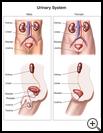
Urethritis in Females: Teen Version
________________________________________________________________________
KEY POINTS
- Urethritis is irritation or infection of the tube that empties urine from the bladder.
- Urethritis is usually treated with medicine.
- It helps if you avoid activities, chemicals, or other irritants that cause redness, burning, or itching in the genital area. Always use latex or polyurethane condoms the right way during sex to help prevent infection.
________________________________________________________________________
What is urethritis?
Urethritis is irritation or infection of the urethra. The urethra is the tube that empties urine from the bladder. A woman's urethra is short (about 1 and 1/2 inches long). Its opening is just above the vagina and not far from the anus (rectal area). This means it is easy for bacteria to enter a woman’s urethra from these areas.
What is the cause?
Urethritis may be caused by an infection. Yeast infections or sexually transmitted diseases or infections (also called an STD or STI) such as chlamydia or gonorrhea, are common causes.
Urethritis may also be caused by irritation of the genital area from:
- Rubbing or pressure from tight clothing or sex
- Physical activity causing pressure in the genital area such as bicycle riding
- Irritants such as soap, body powder, and spermicides
Lack of the female hormone estrogen causes the tissues of the urethra and bladder to get thinner and drier after menopause. This is a common cause of urethritis in older women.
What are the symptoms?
Symptoms may include:
- Pain when you urinate
- Feeling the need to urinate often
- A feeling that your bladder is never empty
- Pain during sex
How is it diagnosed?
Your healthcare provider will ask about your symptoms and medical history and examine you. Your provider may swab the urethral area and cervix to test for bacteria in the lab. A sample of your urine may be tested for infection. You may also have blood tests.
How is it treated?
Your healthcare provider will likely prescribe antibiotic medicine if your symptoms are caused by bacteria. Symptoms caused by an infection should stop within a few days after you start taking antibiotic medicine. Take the medicine for as long as your healthcare provider prescribes, even if you feel better. If you stop taking the medicine too soon, you may not kill all of the bacteria and you may get symptoms again.
If your symptoms are caused by an STD or STI, treating the infection should help. Your recent sexual partners should also be treated.
Your provider may prescribe another medicine to help relieve burning with urination and discomfort in the bladder.
How can I help take care of myself?
Follow the full course of treatment prescribed by your healthcare provider. In addition:
- Drink plenty of liquids each day to help flush the bladder and the rest of the urinary tract.
- If you have an STD or STI, do not have sex before both you and your partners have finished all of the medicine. Ask your provider when you can have sex again.
- Ask your provider:
- How and when you will get your test results
- How long it will take to recover
- If there are activities you should avoid and when you can return to normal activities
- How to take care of yourself at home
- What symptoms or problems you should watch for and what to do if you have them
- Make sure you know when you should come back for a checkup.
How can I help prevent urethritis?
- Avoid tight clothes in the genital area such as control-top pantyhose and tight jeans or leggings. Take wet bathing suits off right away.
- Don’t use irritating cosmetics or chemicals in your genital area. This includes, for example, strong scented soaps, feminine hygiene sprays, douches, scented products such as tampons, sanitary napkins, or panty liners.
- Keep your vaginal area clean. Wiping from front to back after using the toilet may help prevent infections. Use mild, unscented soap to wash your genital area gently each time you bathe or shower.
- Wear underwear that is all cotton or has a cotton crotch. Pantyhose should also have a cotton crotch. Cotton keeps your body cooler than nylon. Change underwear and pantyhose every day.
- During pregnancy, tell your healthcare provider if you are having urinary tract symptoms.
- If you are sexually active, have just 1 sexual partner who is not sexually active with anyone else and who will use protection every time you have sex.
- Ask your partner to get tested for chlamydia, gonorrhea, HIV, and other STDs.
- Avoid any chemicals, including scents, colors, or flavors in condoms, before or during sex. Using unscented lubricant, such as KY jelly, is OK.
- Urinate before and after sex.
- Use latex or polyurethane condoms the right way during foreplay and every time you have vaginal, oral, or anal sex to help prevent infection with an STD or STI.
Last modified: 2022-01-03
Last reviewed: 2019-06-27

